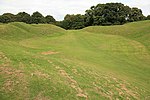Siddington, Gloucestershire

Siddington is a village and civil parish in Gloucestershire, England. It is located immediately south of Cirencester. At the 2011 United Kingdom Census, the parish had a population of 1,249. There is evidence of Neolithic inhabitation of the area. Situated adjacent to Ermin Way, the Roman road connecting present-day Gloucester and Silchester, Siddington has multiple examples of Romano-British settlements. The village was mentioned in the Domesday Book, and parts of the church are Norman. During the Industrial Revolution, the Thames and Severn Canal was built through the parish, followed by the Cirencester branch line and the Swindon and Cheltenham Extension Railway in the 1840s and 1880s respectively. Siddington is located near the Cotswolds AONB, and parts of the Cotswold Water Park SSSI are within the parish.
Excerpt from the Wikipedia article Siddington, Gloucestershire (License: CC BY-SA 3.0, Authors, Images).Siddington, Gloucestershire
Post Office Square, Cotswold District Siddington
Geographical coordinates (GPS) Address Nearby Places Show on map
Geographical coordinates (GPS)
| Latitude | Longitude |
|---|---|
| N 51.6975 ° | E -1.9513888888889 ° |
Address
Siddington
Post Office Square
GL7 6HD Cotswold District, Siddington
England, United Kingdom
Open on Google Maps




